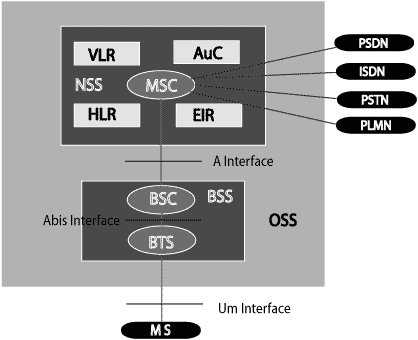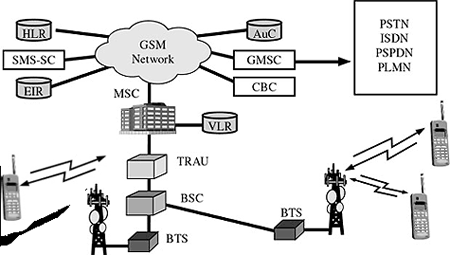GSM - Architecture
A GSM network consists of several functional entities, whose functions and interfaces are defined. The GSM network can be divided into following broad parts.
Following is the simple architecture diagram of GSM Network:

The added components of the GSM architecture include the functions of the databases and messaging systems:
- Home Location Register (HLR)
- Visitor Location Register (VLR)
- Equipment Identity Register (EIR)
- Authentication Center (AuC)
- SMS Serving Center (SMS SC)
- Gateway MSC (GMSC)
- Chargeback Center (CBC)
- Transcoder and Adaptation Unit (TRAU)
Following is the diagram of GSM Netwrok along with added elements:

The MS and the BSS communicate across the Um interface, also known as the air interface or radio link. The BSS communicates with the Network Service Switching center across the A interface.
GSM network areas:
In a GSM network, the following areas are defined:
- Cell: Cell is the basic service area: one BTS covers one cell. Each cell is given a Cell Global Identity (CGI), a number that uniquely identifies the cell.
- Location Area: A group of cells form a Location Area. This is the area that is paged when a subscriber gets an incoming call. Each Location Area is assigned a Location Area Identity (LAI). Each Location Area is served by one or more BSCs.
- MSC/VLR Service Area: The area covered by one MSC is called the MSC/VLR service area.
- PLMN: The area covered by one network operator is called PLMN. A PLMN can contain one or more MSCs.
GSM - Specification
Specifications for different Personal Communication Services (PCS) systems vary among the different PCS networks. The GSM specification is listed below with important characteristics.
Modulation:
Modulation is a form of change process where we change the input information into a suitable format for the transmission medium. We also changed the information by demodulating the signal at the receiving end.
The GSM uses Gaussian Minimum Shift Keying (GMSK) modulation method.
Access Methods:
Because radio spectrum is a limited resource shared by all users, a method must be devised to divide up the bandwidth among as many users as possible.
GSM chose a combination of TDMA/FDMA as its method. The FDMA part involves the division by frequency of the total 25 MHz bandwidth into 124 carrier frequencies of 200 kHz bandwidth.
One or more carrier frequencies are then assigned to each BS. Each of these carrier frequencies is then divided in time, using a TDMA scheme, into eight time slots. One time slot is used for transmission by the mobile and one for reception. They are separated in time so that the mobile unit does not receive and transmit at the same time.
Transmission Rate:
The total symbol rate for GSM at 1 bit per symbol in GMSK produces 270.833 K symbols/second. The gross transmission rate of the time slot is 22.8 Kbps.
GSM is a digital system with an over-the-air bit rate of 270 kbps.
Frequency Band:
The uplink frequency range specified for GSM is 933 - 960 MHz (basic 900 MHz band only). Thedownlink frequency band 890 - 915 MHz (basic 900 MHz band only).
Channel Spacing:
This indicates separation between adjacent carrier frequencies. In GSM, this is 200 kHz.
Speech Coding:
GSM uses linear predictive coding (LPC). The purpose of LPC is to reduce the bit rate. The LPC provides parameters for a filter that mimics the vocal tract. The signal passes through this filter, leaving behind a residual signal. Speech is encoded at 13 kbps.
Duplex Distance:
The duplex distance is 80 MHz. Duplex distance is the distance between the uplink and downlink frequencies. A channel has two frequencies, 80 MHz apart.
Misc:
- Frame duration: 4.615 mS
- Duplex Technique: Frequency Division Duplexing (FDD) access mode previously known as WCDMA.
- Speech channels per RF channel: 8.

No comments:
Post a Comment